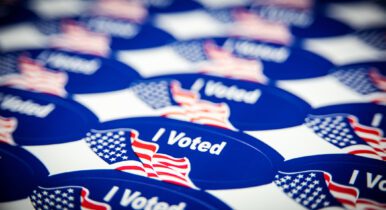Deep Organizing Is Having a Moment
As political campaigns look to the future, one idea keeps coming up: deep organizing. This article explains what it is and why it matters.

As Democrats and Republicans look to the 2022 midterms and beyond, one idea comes up regularly: deep organizing. While campaign GOTV field programs usually take place in the few months or weeks before Election Day, deep organizing takes years.
When Democrats talk about the potential of deep organizing, they can point to their recent wins in Georgia in last year’s presidential election and this year’s Senate runoffs. Georgia’s newly blue tint is widely credited to the long-term outreach work of groups like Stacey Abrams’s Fair Fight, but the Peach State isn’t unique.
Michigan Democrats invested in statewide field organizing after Donald Trump’s 2016 victory, hiring organizers, knocking on doors and connecting with voters far earlier in an election cycle than they had before. Their work paid off, with Democrats winning big in the state in the 2018 midterms and holding the line for Joe Biden in 2020.
Now, Democratic parties in states like Texas are pleading for the resources to invest in similar programs, often focused on communities long neglected or taken for granted. By starting early and staying for the duration, Texas Democrats hope to register hundreds of thousands of voters, perhaps enough to counter recent Republican gains among Latino voters in the state. Simply showing up would be a start, since the Biden campaign deployed all of five field organizers in the entire Rio Grande Valley, a region with three million residents.
Republicans can point to unexpected victories in the Valley as an example of their own organizing prowess last year, since they won counties that usually go for Democrats. While Trump’s unique appeal likely drove some of that elevated conservative turnout, local Republicans worked for the rest. Now, the Texas GOP talks about expanding their reach among minority voters in the years to come, while the national party plans to open year-round “community centers” to reach Black voters in states likely to be competitive in the midterms.
Besides its long-term persistence, deep organizing also differs from GOTV-focused field in its aspiration to persuade voters as well as turn them out. In the words of Texas Democrats, “broad field work helps us find persuadable voters” and builds “long-term relationships with those voters”, driven by “humans talking to humans year-round.”
A comprehensive long-term persuasion machine could also pair field organizing with highly targeted persuasion advertising, with ads opening the door to face-to-face conversations and reinforcing the themes organizers discuss in person. Staff and volunteers can only meet with so many people each day, but digital ads can tickle people’s minds for months on end.
Deep organizing usually involves community-based partners, in part, because shy voters often respond best to people who look and sound like them. Local groups can speak more personally to voters’ concerns, since they talk the language (in the case of some immigrant communities, literally). In Georgia, for example, Abrams had many allies on the ground, some of whose work preceded hers by years.
Likewise, Democrats in Arizona benefited from a 10-year struggle against both state immigration laws and elected officials like Maricopa County Sheriff Joe Arpaio, a Trump favorite. In Arizona, local victories built connections and confidence alike, helping to create the conditions for Biden to carry the state.
Of course, deep organizing can require deep pockets, since field organizers need to eat, live and buy gas. Data infrastructure, training and technology take up more resources, but ideally an organizing program will naturally grow beyond its paid roots. As paid staff recruit and train local activists, those new advocates can self-organize within their own social circles and expand the program organically. In any case, even a sizable field effort would likely cost less than campaigns and outside groups routinely waste on repetitive and poorly targeted TV ads every cycle.
Deep organizing isn’t a panacea, since no amount of persuasion can help a political party sell an agenda that the voters don’t want to buy. And as polarized as American politics has become, relatively few people who’ve already taken a side may be open to changing their minds at all.
But by embedding themselves in a community and listening to people’s needs and fears, deep organizers can build the kind of connections that bring new voters into the process and keep them engaged for years to come. Assuming, that is, that they’re able to cast a ballot at all. For Democrats, fighting for the right to vote will likely provide those new recruits their first vital task.
Colin Delany is founder and editor of the award-winning website Epolitics.com, author of the new 2021 edition of “How to Use the Internet to Change the World – and Win Elections,” a twenty-five-year veteran of online politics and a perpetual skeptic. See something interesting? Send him a pitch at cpd@epolitics.com.


